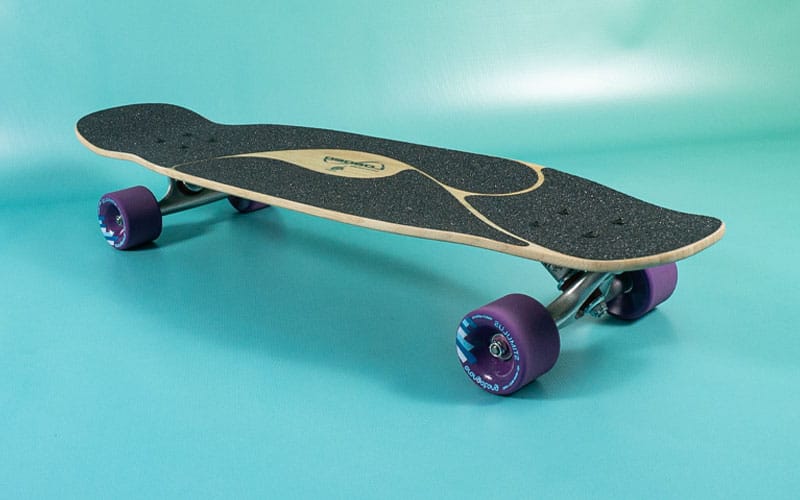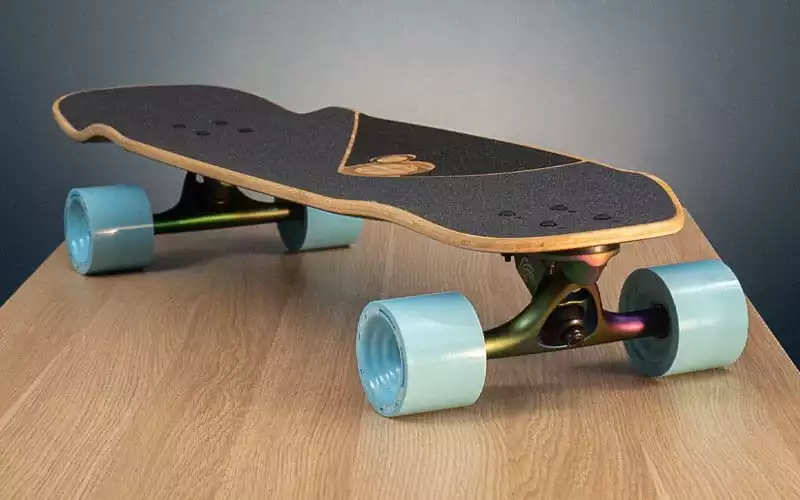The
Affiliate disclaimer: We earn a commission if you make a purchase, at no additional cost to you.
Deck
Length: 34″ / 86.4 cm
Width: 8.5″ / 21.6 cm
Wheelbase: 21″ / 53.3 cm
Deck Weight: 3.1 lb / 1.4 kg
The deck is a symmetrical shape that’s solid for freestyle tricks.
It has an absolutely beautiful graphic crafted by Retoka, a design studio based in Barcelona. I love the retro design.

Its bamboo core is sandwiched between fiberglass and bonded with epoxy resin, making it flexible and light.
The flex makes it enjoyable to push because it acts as a nano-drop.
It has subtle rocker and concave – Specifically, the concave is about a ¼” deep in the center and gradually flattens toward the kicktails.
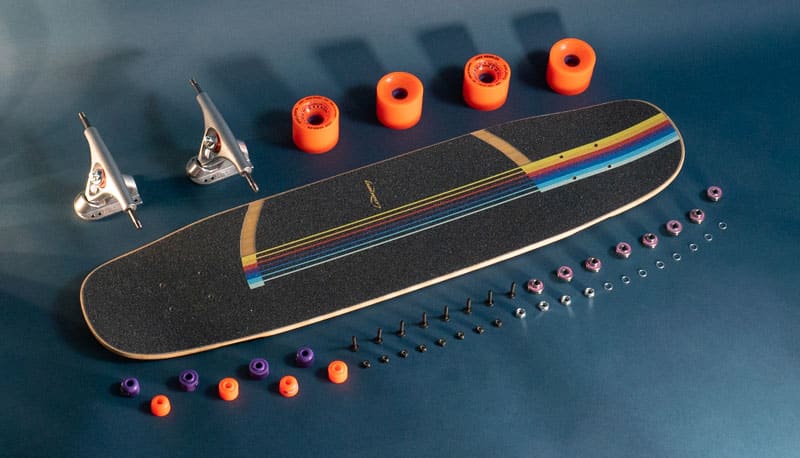
Which exist but are on the shorter side. They allow you to dabble with shuvits, manuals, and whatever other freestyle trickery you’re doing.
Don’t get me wrong; I’ve seen people do some pretty steezy freestyle on it.
And some CNC wheel wells allow for 65mm wheels without any wheelbite. I discuss testing different wheel sizes further down in this review.


Wheels
Diameter: 65mm
Contact Patch: 50mm
Durometer: 80a
Core: Offset
The wheels are 65mm 80a Oragantang Love Handles equipped with
So, pairing it with this type of setup makes a lot of sense.
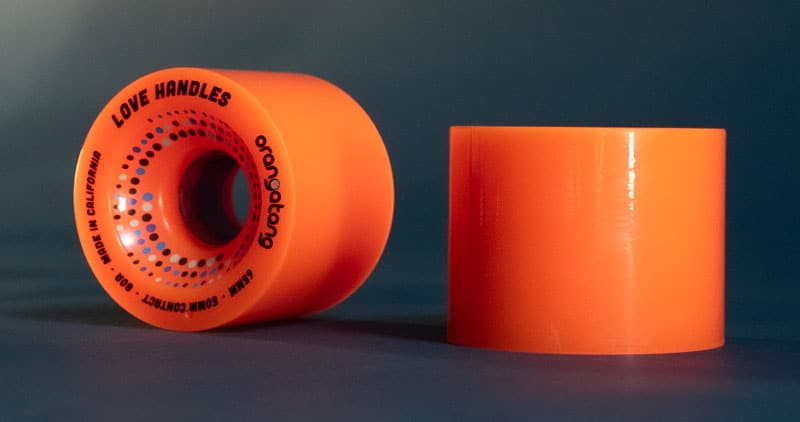
Now for the other wheels I tested.
First, I tried 65mm 86a orangutan Fat Free wheels, which have rounded lips and stonegrounded contact patches. From the perspective of powersliding and freestyle, these wheels make more sense than the Love Handles since the rounded lips are more forgiving.

I also tried 70mm 4presidents, 75mm In Heats, and 85mm Caguamas. For context, I weigh around 165lbs.
Surprisingly, I didn’t experience wheelbite with the 70s, but obviously, it comes down to your weight and riding style. If you weigh more than me and do slower turns, that will increase your chances of wheelbite.
Not surprisingly, I experienced wheelbite with the 75s and 85s. I solved it using a ¼” riser for the 75s and ⅜” riser for the 85s.
After testing all of these different wheels, my main takeaway was that the Love Handles make the most sense for this setup, and that’s what I will keep on it – Loaded knows what they’re doing.
Trucks
Hangar: 150mm
Baseplate Angle: 50°
Bushings: Cone & Barrel
The 150mm Paris 50° RKPs are mounted with 1” button heads and have 90a barrel and cone bushings.
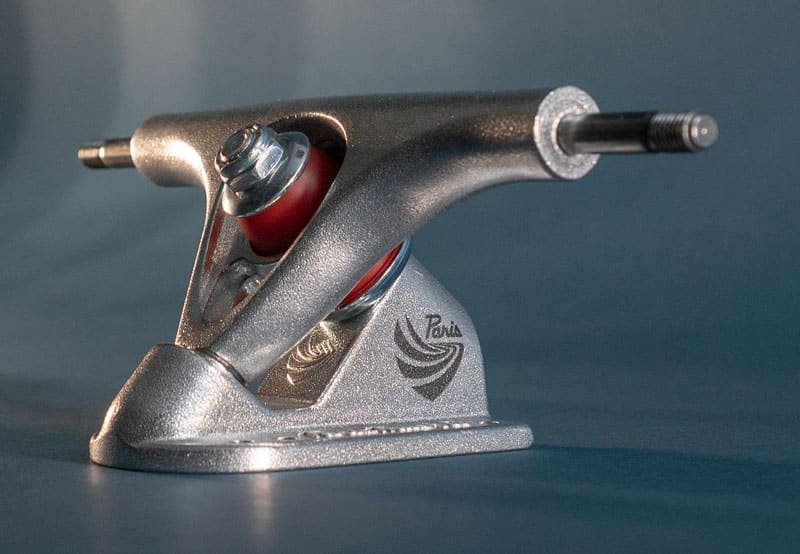
Bushings
Type: Barrel & Cone
Stock Paris: Red 90a
Medium Knuckles: Purple 90a
Soft Knuckles: Orange 87a
The 150mm Paris RKPs come stock with 90a barrel and cone bushings.
I swapped the stock Paris 90a bushings for Orangatang orange and purple knuckles. This is probably the trickiest thing to translate over the internet. I’d encourage you to test for yourself.

My main takeaway was that the purple and orange knuckles felt like I was getting more juice out of my pumps. I don’t know how else to describe it. I enjoyed the double orange knuckle setup because my riding style is focused on deep carves, averaging a speed of 8-12mph.
Overall, the stock bushings feel solid, but I would recommend experimenting.

Bearings
Type: Built-Ins
Shields: Double-Capped
Material: Chromium Steel
Loaded Jehunion (JEHU) V2 Bearings made in Taiwan using Japanese grease.

Riding Feel
Now that’s all the parts of the Chinchiller, but how does everything work together and feel to ride?
Well, when you mix a 21” wheelbase with 50° RKPs that are top-mounted to a flexy deck, it can perform deep carves and be pretty pumpable.
Not pumpable from a standstill like a pivoting surfskate adapter, but once you start to pick up some speed, you can really get into a fun pumpy rhythm.

The deck flex paired with soft wheels absorbs rougher environments well. However, if you’re riding in a rough environment consistently, you might want to consider a larger wheel with more urethane.
The short, mellow kicktails are functional for shove-its and manuals, but I found them the most functional for repositioning and pivoting.
While I do some occasional freestyle on it, I use it mostly for casual cruising and deep carving. But, like all of these reviews, I want to emphasize that it’s a personal preference scenario. You might want more mellow kicktails for the freestyle you’re trying to achieve, idk.
Comparisons
Loaded Poke
Length
34” / 86 cm
Width
9.125” / 23.18 cm
Wheelbase
20.75” / 52.71 cm
Loaded Coyote
Length
30.75” / 78.1 cm
Width
8.375” / 21.3 cm
Wheelbase
17.5” / 44.5 cm
Loaded Omakase
Length
33.5″ / 85.1 cm
Width
10″ / 25.4 cm
Wheelbase
20.75-22″
52.7-55.8 cm
Loaded Chinchiller vs Poke
I think most people will compare the Chinchiller to the Poke since they have similar specs. So, let’s do a comparison.
The first obvious difference just by looking at it is that the Chinchiller has a symmetrical shape while the Poke has a directional shape. The kicktail of the Poke is a higher angle and about an inch longer (5.25” from the bolts) than the Chinchillers kicktails. And the nose of the Poke is about an inch shorter than the Chinchiller kicks.
Riding these, two main things stuck out to me – the deck flex and concave. The Chinchiller flexes a good amount more than the Poke. As a result, you can carry your momentum more efficiently while pumping with the chinchiller. Sure, the Poke flexes, but alternating between the two felt a lot stiffer than the chiller. As a result of less flex, the poke felt a little harsher since it wasn’t absorbing as much. But there’s a tradeoff – a stiffer deck is easier to throw out and slide.
The second thing that stood out was the Poke has a more noticeable amount of concave – it’s about a quarter of an inch deeper than the chiller.
If someone asked me to help them pick, I’d hit em with…Do you want something that’s more functional for slides, and freestyle? Then the Poke probably makes more sense since it’s stiffer, has more aggressive griptape and deeper concave. Or do you want something that’s more functional for deeper carving and pumping. You can’t go wrong with either – they’re both solid.


